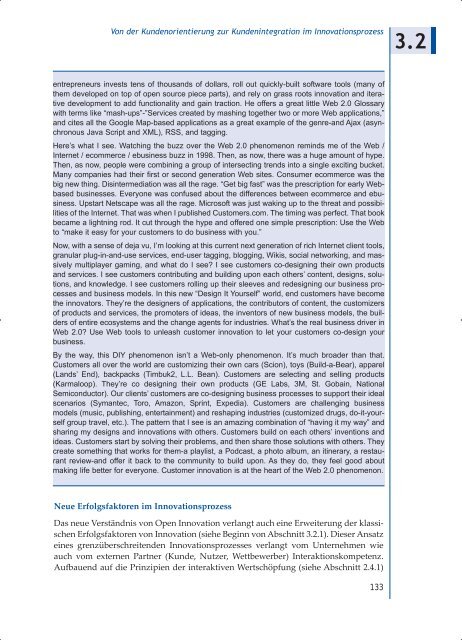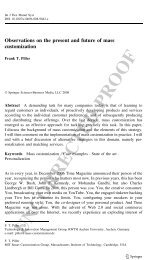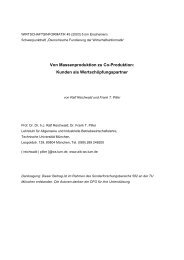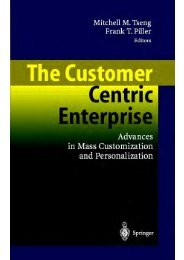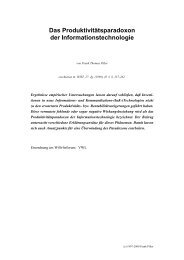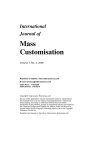Reichwald, Ralf / Piller, Frank
Reichwald, Ralf / Piller, Frank
Reichwald, Ralf / Piller, Frank
Erfolgreiche ePaper selbst erstellen
Machen Sie aus Ihren PDF Publikationen ein blätterbares Flipbook mit unserer einzigartigen Google optimierten e-Paper Software.
Von der Kundenorientierung zur Kundenintegration im Innovationsprozess<br />
entrepreneurs invests tens of thousands of dollars, roll out quickly-built software tools (many of<br />
them developed on top of open source piece parts), and rely on grass roots innovation and iterative<br />
development to add functionality and gain traction. He offers a great little Web 2.0 Glossary<br />
with terms like “mash-ups”-”Services created by mashing together two or more Web applications,”<br />
and cites all the Google Map-based applications as a great example of the genre-and Ajax (asynchronous<br />
Java Script and XML), RSS, and tagging.<br />
Here’s what I see. Watching the buzz over the Web 2.0 phenomenon reminds me of the Web /<br />
Internet / ecommerce / ebusiness buzz in 1998. Then, as now, there was a huge amount of hype.<br />
Then, as now, people were combining a group of intersecting trends into a single exciting bucket.<br />
Many companies had their first or second generation Web sites. Consumer ecommerce was the<br />
big new thing. Disintermediation was all the rage. “Get big fast” was the prescription for early Webbased<br />
businesses. Everyone was confused about the differences between ecommerce and ebusiness.<br />
Upstart Netscape was all the rage. Microsoft was just waking up to the threat and possibilities<br />
of the Internet. That was when I published Customers.com. The timing was perfect. That book<br />
became a lightning rod. It cut through the hype and offered one simple prescription: Use the Web<br />
to “make it easy for your customers to do business with you.”<br />
Now, with a sense of deja vu, I’m looking at this current next generation of rich Internet client tools,<br />
granular plug-in-and-use services, end-user tagging, blogging, Wikis, social networking, and massively<br />
multiplayer gaming, and what do I see? I see customers co-designing their own products<br />
and services. I see customers contributing and building upon each others’ content, designs, solutions,<br />
and knowledge. I see customers rolling up their sleeves and redesigning our business processes<br />
and business models. In this new “Design It Yourself” world, end customers have become<br />
the innovators. They’re the designers of applications, the contributors of content, the customizers<br />
of products and services, the promoters of ideas, the inventors of new business models, the builders<br />
of entire ecosystems and the change agents for industries. What’s the real business driver in<br />
Web 2.0? Use Web tools to unleash customer innovation to let your customers co-design your<br />
business.<br />
By the way, this DIY phenomenon isn’t a Web-only phenomenon. It’s much broader than that.<br />
Customers all over the world are customizing their own cars (Scion), toys (Build-a-Bear), apparel<br />
(Lands’ End), backpacks (Timbuk2, L.L. Bean). Customers are selecting and selling products<br />
(Karmaloop). They’re co designing their own products (GE Labs, 3M, St. Gobain, National<br />
Semiconductor). Our clients’ customers are co-designing business processes to support their ideal<br />
scenarios (Symantec, Toro, Amazon, Sprint, Expedia). Customers are challenging business<br />
models (music, publishing, entertainment) and reshaping industries (customized drugs, do-it-yourself<br />
group travel, etc.). The pattern that I see is an amazing combination of “having it my way” and<br />
sharing my designs and innovations with others. Customers build on each others’ inventions and<br />
ideas. Customers start by solving their problems, and then share those solutions with others. They<br />
create something that works for them-a playlist, a Podcast, a photo album, an itinerary, a restaurant<br />
review-and offer it back to the community to build upon. As they do, they feel good about<br />
making life better for everyone. Customer innovation is at the heart of the Web 2.0 phenomenon.<br />
Neue Erfolgsfaktoren im Innovationsprozess<br />
Das neue Verständnis von Open Innovation verlangt auch eine Erweiterung der klassischen<br />
Erfolgsfaktoren von Innovation (siehe Beginn von Abschnitt 3.2.1). Dieser Ansatz<br />
eines grenzüberschreitenden Innovationsprozesses verlangt vom Unternehmen wie<br />
auch vom externen Partner (Kunde, Nutzer, Wettbewerber) Interaktionskompetenz.<br />
Aufbauend auf die Prinzipien der interaktiven Wertschöpfung (siehe Abschnitt 2.4.1)<br />
133<br />
3.2


